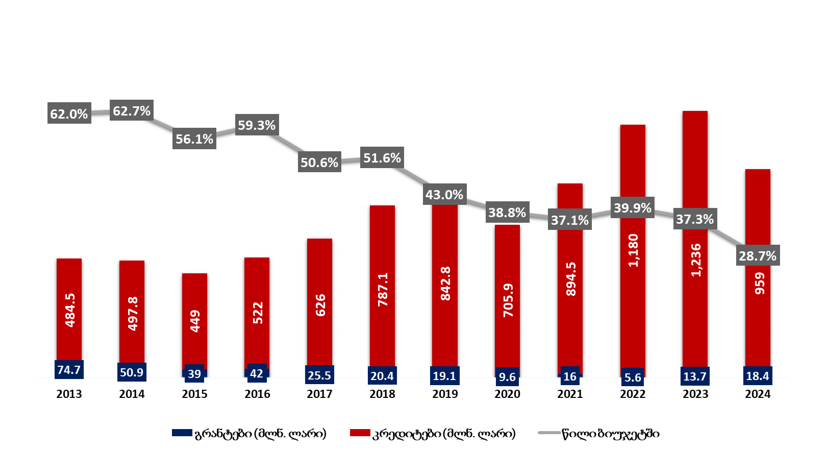In the recent period, the foreign influence transparency law has been actively discussed in Georgia and has already been passed by the Parliament of Georgia in three readings. As far as we know, this transparency law declares that all the non-governmental or media organisations which receive 20% of their funding from foreign sources are agents of foreign influence.
Between 2013 and 2023, the foreign grants and loans made up 16% of the state budget. In these 11 years, the state budget has received GEL 23 billion in loans and GEL 3.4 billion in grants from abroad in total. According to the 2024 plan, over GEL 2 billion of foreign funding is expected to be received (see the article for more details).
The Ministry of Regional Development and Infrastructure implements the largest projects in Georgia. Therefore, it is logical that a large share of foreign funding would go to this Ministry.
FactCheck looked into the share of the Ministry of infrastructure’s budget coming from foreign grants and loans during the Georgian Dream’s governance.
The Ministry of Regional Development and Infrastructure’s budget is set at GEL 3.4 billion in 2024. Of that figure, GEL 2.4 billion is budgetary funds, GEL 18.4 million is grants and GEL 959 million is loans. Therefore, 28.7% of the Ministry’s funding for the current year comes from abroad (grants and loans combined).
Chart 1: Share of Foreign Loans and Grants in the Budget of the Ministry of Regional Development and Infrastructure

Source: Ministry of Finance
According to the statistical data, after the Georgian Dream came to power, the share of foreign grants and loans in the budget of the Ministry of Regional Development and Infrastructure reached 47%. Between 2013 to 2018, this figure was more than 50% of the budget whilst it ranged from 29% to 43% in 2019 to 2024. The smallest figure in recent years was in this year when the share of foreign grants and loans in the Ministry’s budged is near 29% which, of course, is not a low amount.
From the Ministry of Regional Development and Infrastructure’s nearly GEL 1 billion loan, GEL 689 million of this will be used to improve road infrastructure, GEL 73 million will be spent for the rehabilitation of municipal infrastructure, GEL 94 million is earmarked for the restoration and rehabilitation of water supply infrastructure and GEL 31.1 million will be used for the solid waste management programme. Therefore, 36%, 23%, 17% and 48%, respectively, of the funding for the most strategic sectors come from foreign loans and grants.
The largest project that is being implemented under the Georgian Dream’s government (which began in 2006 during the United National Movement’s rule with 68 km of road already built) is the high-speed highway. According to this year’s budget, the funding for this project is GEL 1,225 million of which foreign grants and loans make up EL 689 million or 56% of the total funding. The main funders of the project are the Asian Development Bank, the European Investment Bank, the World Banks and the European Bank for Reconstruction and Development.
In conclusion, it can be said that under the rule of the current government, 47% of the funding for the Ministry of Regional Development and Infrastructure is comprised of foreign funds. All of the larger projects are mostly funded by foreign financial institutions. For the high-speed highway project alone, of which the Georgian Dream is very proud, more than half or 56% of this year’s budget is made up of foreign loans.







